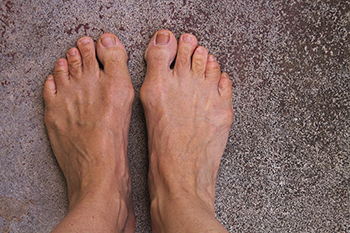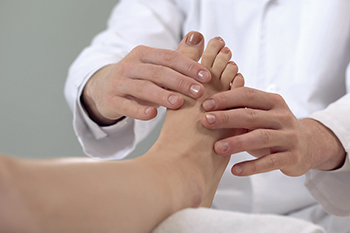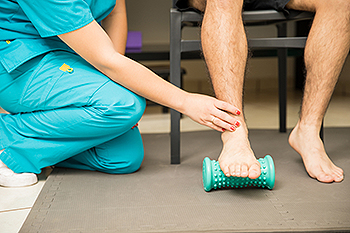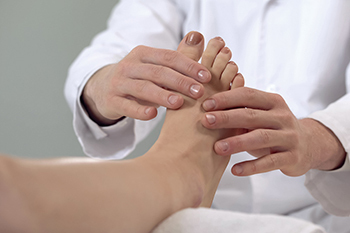Items filtered by date: September 2022
What Can Cause Bunions?

A bunion is a common foot condition that affects millions of people worldwide, and it is considered to be a deformity. Many people can develop a bunion from genetic reasons, or from wearing shoes that do not have enough room for the toes to move freely in. It is noticeable as a bony lump that gradually forms on the side of the big toe, and larger shoes may need to be purchased. If the bunion is large, it may cause the other toes to shift toward each other, which may result in pain and discomfort. Additional symptoms that can accompany a bunion can include calluses forming on the second toe, inflamed skin on the big toe, and the toes may be hard to move. There may be a decreased range of motion in the big toe, and patients may experience chronic pain. Mild relief may be found when the correct size and style shoes are worn, and a protective covering may be put over the bunion which may help to reduce friction. A podiatrist is qualified to diagnose and treat bunions, and it is strongly suggested that you confer with this type of doctor if you have this foot condition.
If you are suffering from bunions, contact Glenn Aufseeser, DPM of Lakewood Foot and Ankle Specialists. Our doctor can provide the care you need to keep you pain-free and on your feet.
What Is a Bunion?
A bunion is formed of swollen tissue or an enlargement of boney growth, usually located at the base joint of the toe that connects to the foot. The swelling occurs due to the bones in the big toe shifting inward, which impacts the other toes of the foot. This causes the area around the base of the big toe to become inflamed and painful.
Why Do Bunions Form?
Genetics – Susceptibility to bunions are often hereditary
Stress on the feet – Poorly fitted and uncomfortable footwear that places stress on feet, such as heels, can worsen existing bunions
How Are Bunions Diagnosed?
Doctors often perform two tests – blood tests and x-rays – when trying to diagnose bunions, especially in the early stages of development. Blood tests help determine if the foot pain is being caused by something else, such as arthritis, while x-rays provide a clear picture of your bone structure to your doctor.
How Are Bunions Treated?
- Refrain from wearing heels or similar shoes that cause discomfort
- Select wider shoes that can provide more comfort and reduce pain
- Anti-inflammatory and pain management drugs
- Orthotics or foot inserts
- Surgery
If you have any questions, please feel free to contact our offices located in Lakewood and Manchester Township, NJ . We offer the newest diagnostic and treatment technologies for all your foot care needs.
Diabetes and Heel Fissures

Cracked heels, or heel fissures, are cracks or splits in the skin on the soles of the feet, often going through to the inner layers of skin. They can be painful when pressure is applied to the skin while standing, and they can bleed. This condition generally comes from dry skin. Loss of nerve supply to the sweat glands in the feet can happen to diabetics, because they tend to have drier skin than others. Heel fissures are common in the general population, but those with diabetes can have more serious consequences if they do not deal with cracked heels effectively. Diabetics can also suffer from neuropathy, causing loss of feeling in the feet. With the loss of sensation, patients with diabetes can have fissures that bleed and can possibly become infected and ulcerated without knowing it. If you are a diabetic, make sure to visually inspect your feet regularly. If you have cracked heels or some other foot problem, it is important for you to see a podiatrist for prompt treatment.
Diabetic foot care is important in preventing foot ailments such as ulcers. If you are suffering from diabetes or have any other concerns about your feet, contact Glenn Aufseeser, DPM from Lakewood Foot and Ankle Specialists. Our doctor can provide the care you need to keep you pain-free and on your feet.
Diabetic Foot Care
Diabetes affects millions of people every year. The condition can damage blood vessels in many parts of the body, especially the feet. Because of this, taking care of your feet is essential if you have diabetes, and having a podiatrist help monitor your foot health is highly recommended.
The Importance of Caring for Your Feet
- Routinely inspect your feet for bruises or sores.
- Wear socks that fit your feet comfortably.
- Wear comfortable shoes that provide adequate support.
Patients with diabetes should have their doctor monitor their blood levels, as blood sugar levels play such a huge role in diabetic care. Monitoring these levels on a regular basis is highly advised.
It is always best to inform your healthcare professional of any concerns you may have regarding your feet, especially for diabetic patients. Early treatment and routine foot examinations are keys to maintaining proper health, especially because severe complications can arise if proper treatment is not applied.
If you have any questions please feel free to contact our offices located in Lakewood and Manchester Township, NJ . We offer the newest diagnostic and treatment technologies for all your foot and ankle needs.
Gout Pain Can Be Managed
Prevention of Plantar Fasciitis

Plantar fasciitis is a condition condition involving inflammation in the ligament that extends from the toes to the heels. It is one of the most common causes of heel pain. This affliction can cause sharp pain, especially when arising in the morning, and can interfere with walking or exercise. Plantar fasciitis is caused by activities that place stress on the heel, such as running or jumping, and standing on hard surfaces for a prolonged period of time. Additionally, obesity and aging may contribute significantly to developing plantar fasciitis. Preventive measures that can be taken may include varying exercise routines to work different muscles and including low impact exercise options to reduce stress on the heel. It may be beneficial to wear a night splint on the affected foot to keep the foot and ankle in the optimal position. If you believe that you have plantar fasciitis, it is strongly suggested that you visit a podiatrist who can properly diagnose this condition and obtain treatment that may be more effective for you.
Plantar fasciitis is a common foot condition that is often caused by a strain injury. If you are experiencing heel pain or symptoms of plantar fasciitis, contact Glenn Aufseeser, DPM from Lakewood Foot and Ankle Specialists. Our doctor can provide the care you need to keep you pain-free and on your feet.
What Is Plantar Fasciitis?
Plantar fasciitis is one of the most common causes of heel pain. The plantar fascia is a ligament that connects your heel to the front of your foot. When this ligament becomes inflamed, plantar fasciitis is the result. If you have plantar fasciitis you will have a stabbing pain that usually occurs with your first steps in the morning. As the day progresses and you walk around more, this pain will start to disappear, but it will return after long periods of standing or sitting.
What Causes Plantar Fasciitis?
- Excessive running
- Having high arches in your feet
- Other foot issues such as flat feet
- Pregnancy (due to the sudden weight gain)
- Being on your feet very often
There are some risk factors that may make you more likely to develop plantar fasciitis compared to others. The condition most commonly affects adults between the ages of 40 and 60. It also tends to affect people who are obese because the extra pounds result in extra stress being placed on the plantar fascia.
Prevention
- Take good care of your feet – Wear shoes that have good arch support and heel cushioning.
- Maintain a healthy weight
- If you are a runner, alternate running with other sports that won’t cause heel pain
There are a variety of treatment options available for plantar fasciitis along with the pain that accompanies it. Additionally, physical therapy is a very important component in the treatment process. It is important that you meet with your podiatrist to determine which treatment option is best for you.
If you have any questions, please feel free to contact our offices located in Lakewood and Manchester Township, NJ . We offer the newest diagnostic and treatment technologies for all your foot care needs.
Flip Flops and Foot Pain

Despite the fact that flip-flops are perhaps one of the most widespread and popular forms of footwear during the summer months, flip-flops can also negatively impact your feet. For example, wearing flip-flops for too long and during prolonged periods of physical activity might contribute to foot pain. Since an individual must tighten and scrunch up their toes to prevent their flip-flops from falling off, this prolonged tension can contribute significantly to foot pain. Also, flip-flops offer a substantially low level of foot support. As the shoe is essentially a mere piece of foam, the wearer does not benefit from any cushioning or padding found in other forms of footwear. This lack of padding can aggravate conditions such as plantar fasciitis, which can cause heel pain. Plantar fasciitis occurs when the plantar fascia, which is a band of tissue running through the arch of the foot, becomes inflamed and strained. Like all things, flip-flops are perhaps best worn in moderation. For instance, if you are taking a walk up the block to go to the beach, wearing flip-flops might be an appropriate choice. However, if you are about to embark on a long walk or hike, selecting a more supportive shoe might be the better option. If you wear flip-flops and experience some kind of foot pain, consider reaching out to a podiatrist who can help you.
Flip-flops are not always the best choice of footwear. If you have any concerns about your feet or ankles, contact Glenn Aufseeser, DPM from Lakewood Foot and Ankle Specialists. Our doctor will assist you with all of your foot and ankle needs.
Flip-Flops and Feet
When the weather starts warming up, people enjoy wearing flip-flops. Flip-flops are comfortable, stylish, and easy to slip on and off; they're perfect for any summer beach goer. However, these shoes can cause harm to the feet.
How Can Flip-Flops Affect Me Long-Term?
- Ankle problems
- Hip problems
- Lower back problems
- Pain in the balls of the feet
- Problems with foot arches
- Changes in the way you walk
Are There Injuries Associated with Flip-Flops?
Yes. Since flip-flops are relatively weak and do not provide the same amount of support as sneakers, people who wear flip-flops regularly are more susceptible to injuries. On top of that, the open nature of the shoe makes your feet more prone to other problems, such as cuts and even infections. Common injuries and ailments include:
- Sprained ankles
- Blisters
- Infections
- Cuts and Scrapes
I like Wearing Flip-Flops. Are There Safe Alternatives?
When buying flip-flops, try to find ones that have sturdy soles and that are made of high-quality materials that will support for your feet. These flip-flops will cost more but will also last longer as a result.
If you have any questions please feel free to contact our offices located in Lakewood and Manchester Township, NJ . We offer the newest diagnostic and treatment technologies for all your foot and ankle needs.

